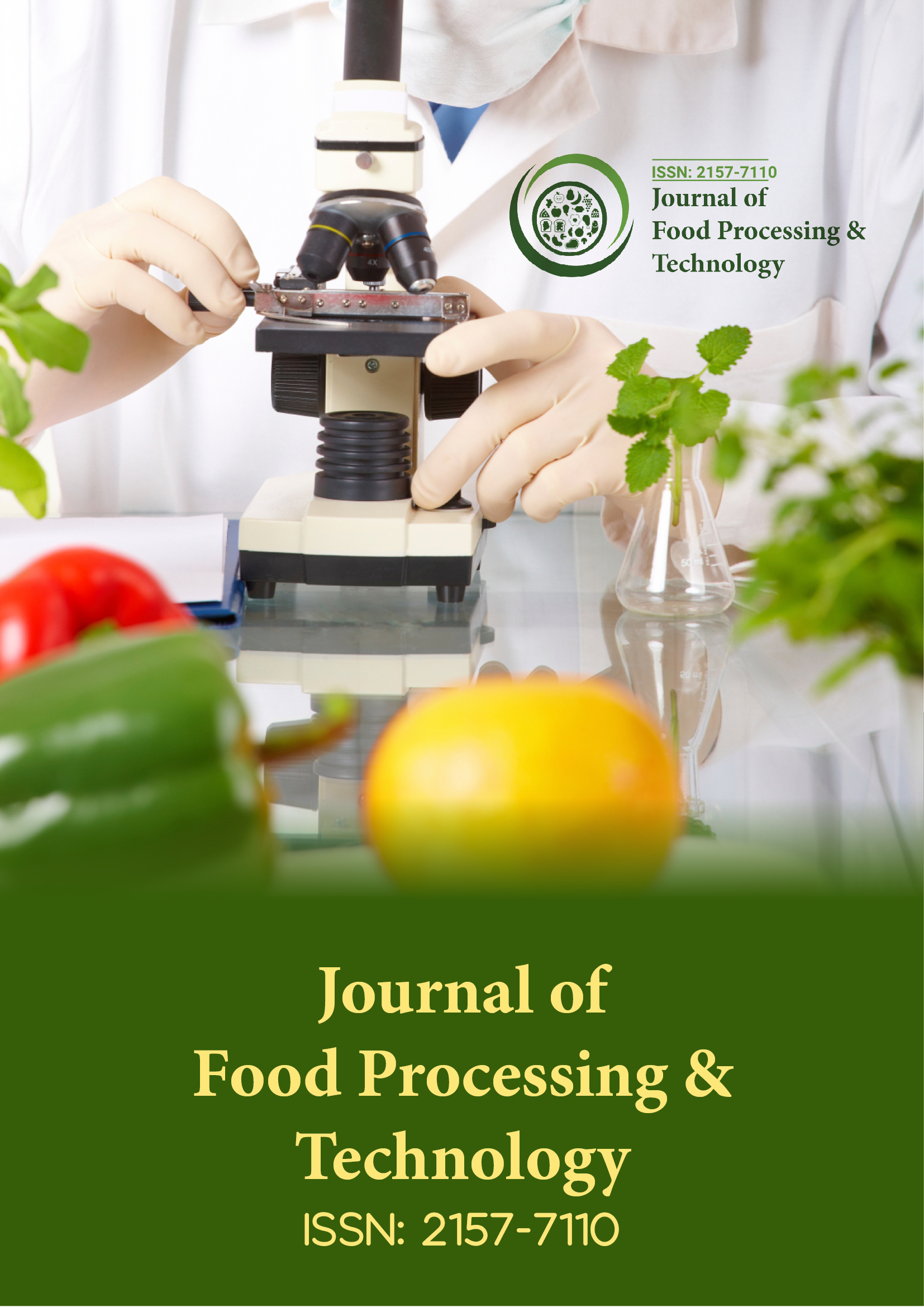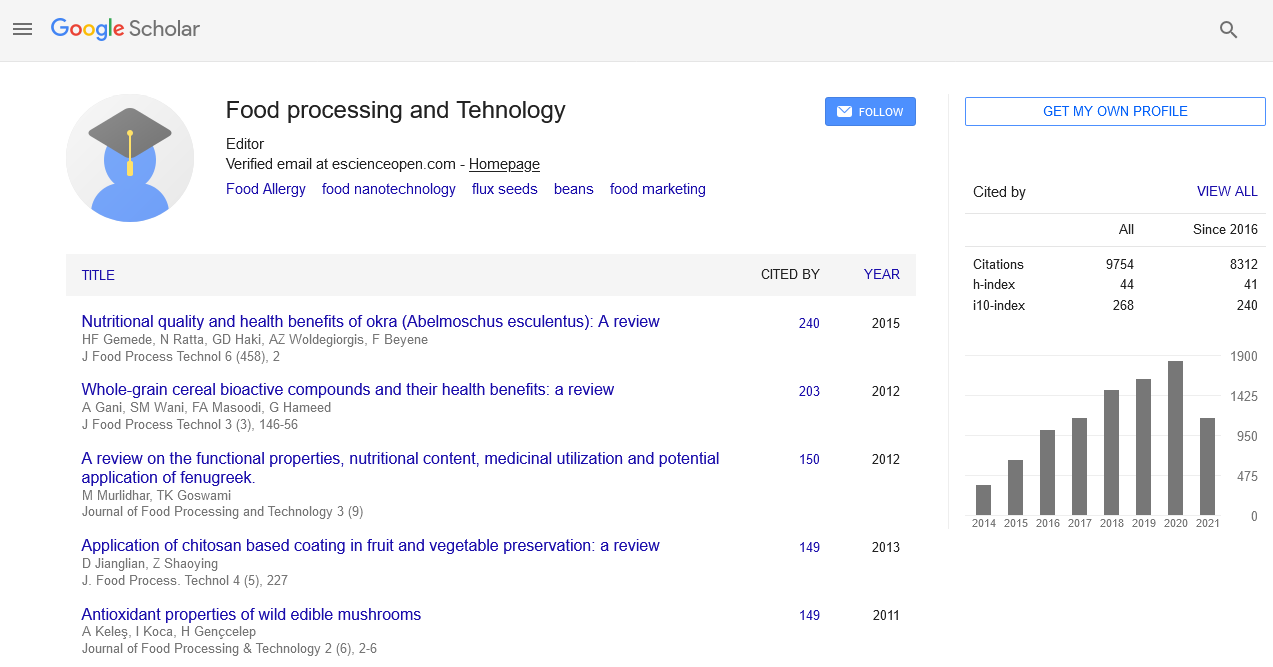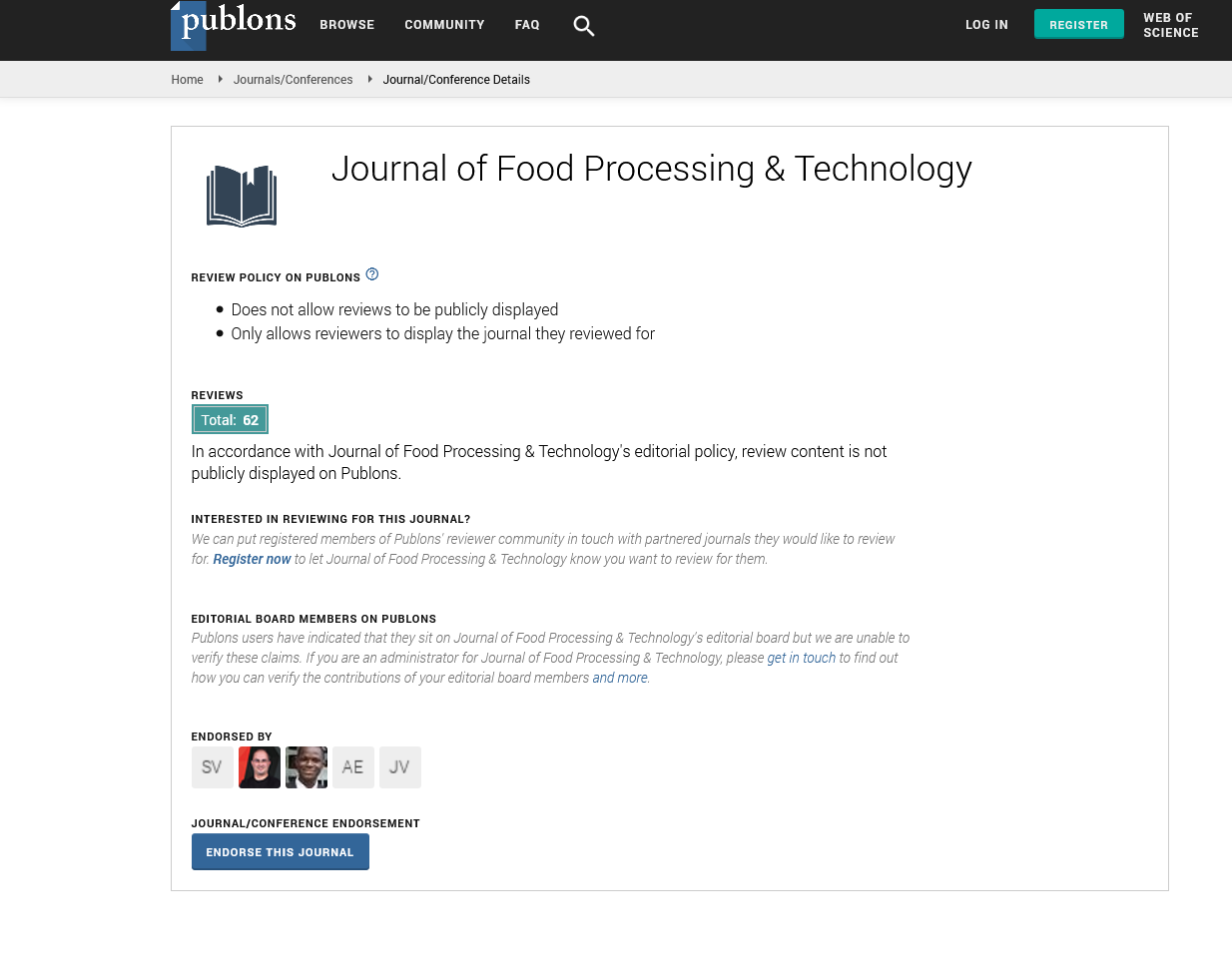Indexed In
- Genamics JournalSeek
- Academic Keys
- JournalTOCs
- China National Knowledge Infrastructure (CNKI)
- Access to Global Online Research in Agriculture (AGORA)
- Centre for Agriculture and Biosciences International (CABI)
- RefSeek
- Directory of Research Journal Indexing (DRJI)
- Hamdard University
- EBSCO A-Z
- OCLC- WorldCat
- Scholarsteer
- SWB online catalog
- Publons
- Euro Pub
- Google Scholar
Useful Links
Share This Page
Journal Flyer

Open Access Journals
- Agri and Aquaculture
- Biochemistry
- Bioinformatics & Systems Biology
- Business & Management
- Chemistry
- Clinical Sciences
- Engineering
- Food & Nutrition
- General Science
- Genetics & Molecular Biology
- Immunology & Microbiology
- Medical Sciences
- Neuroscience & Psychology
- Nursing & Health Care
- Pharmaceutical Sciences
Perspective - (2022) Volume 13, Issue 10
Authentication of Green Technology and Different Categories of Food Processing
Monteiro Eurídice*Received: 03-Oct-2022, Manuscript No. JFPT-22-18671; Editor assigned: 06-Oct-2022, Pre QC No. JFPT-22-18671 (PQ); Reviewed: 20-Oct-2022, QC No. JFPT-22-18671; Revised: 27-Oct-2022, Manuscript No. JFPT-22-18671 (R); Published: 04-Nov-2022, DOI: 10.35248/2157-7110.22.13.958
Description
A collection of technologies used in food processing that preserve ecosystem resilience and food nutrients could be referred to as "green technology" in this context. The forces propelling technological advancement include the fast population and lifestyle increase. A greater population produces more intelligent offspring, which intensifies competition and leads to the creation of highly advanced technologies. For human needs, food is necessary. It affects both the emotional and physical wellbeing of people. To meet the demand for food, technology is unavoidably needed for food processing. With a daily population increase of 265,629 people, the world's population might reach eight billion by the end of 2021. Additionally, the percentage of people living in urban areas has increased and currently estimated to rise to about 68% by 2050. The primary goal of food processing is to transform raw materials, such as plants, animals, fibers, and aquatic organisms, into a variety of shelf-stable consumable foods. One or more processes, such as sorting, cleaning, washing, peeling, freezing, and others are involved in the processing of food.
In order to maintain or improve the quality of the final products, food additives may also be applied during the process. Technology is unquestionably required to improve food quality, processing, and quantity. Iravani defined technology as involving abilities, processes, and understanding of how to employ resources to create desirable things. Pre-harvest, harvest, and post-harvest are only a few of the stages of food production and processing where technology is used. Vertical farming, widespread automation, and GIS-based technology are examples of pre-harvest technology. A robotic crop harvester and an automatic cow milking device are examples of harvesting technology. A wide range of operations, including crop management after harvest, processing, packaging, and transportation, are covered by post-harvest technology. These processes' technologies are interconnected and could have an influence on the quality end outcome. Technology refers to the installation of a system of devices that depend on energy to function. It is challenging to integrate "technology" and the "green concept" to create "Green Technology" because using the equipment may have an environmental impact. Green technology is a concept that minimizes harmful environmental effects by properly using natural resources. These days, several companies have approved the usage of green technologies. Environmental harm that has built up through time compels us to alter our industrial practises in order to save the planet for coming generations. The "green notion" heightens our awareness of how people and nature interact. Everything related to ecologically friendly activities, including energy saving, green packaging, and green management, falls under this category.
The three main categories of food processing techniques are traditional, contemporary, and hybrid. The overall purpose of the procedure, cost, durability, and nutritional value all factor into the choice of processing method. Food waste, environmental harm, nutrient loss, and reduced active chemicals are a few repercussions that could arise during the processing of food. Some people, nevertheless, might not think of these consequences. The simplest way of processing food involves heating ingredients in liquids like water, oil, or water vapor to soften texture and eradicate bacteria so that an edible product results. As a result of technological development, food processing has altered and evolved. For a specific produce, one or more combinations of processing techniques can also be necessary. Traditional thermal processing dates back a long time been shown to improve food shelf life. However, as this technique may affect sensory, performance, and nutritional contents, other approaches, including food irradiation, are frequently used. Irradiation might be able to lessen the issue of microbial contamination without severely impacting the product's functionality. However, because the irradiation dose is applied below the recommended effective dose, it does not completely ensure food safety. This technique may potentially result in nutritional loss and environmental contamination. Technology related to food is always evolving to enhance current processing techniques. It keeps expanding in tandem with how quickly human lifestyle is changing. As a result of modern customer demand for high-quality, "fresh-like," and "natural" foods that require little work and preparation time, ready-to-eat convenient foods preserved using gentle technologies have been introduced. Environmental harm can occasionally be caused when the required technology is used to satisfy this desire. There are several ecologically friendly technologies available currently that were not previously considered for application in the food processing industry.
Citation: Eurídice M (2022) Authentication of Green Technology and Different Categories of Food Processing. J Food Process Technol. 13:958.
Copyright: © 2022 Eurídice M. This is an open access article distributed under the terms of the Creative Commons Attribution License, which permits unrestricted use, distribution, and reproduction in any medium, provided the original author and source are credited.


